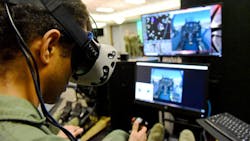Battlefield threats can come from all directions—and, at times, from forces that are not human, such as unmanned aerial vehicles (UAVs) and unmanned ground vehicles (UGVs). Finding a practical defense against such threats (Fig. 1) has become a quest for some leading defense contractors, including Booz Allen Hamilton.
As reported at the firm’s co-sponsored 2018 Directed Energy Summit this past March (Fig. 2), the threats from unmanned vehicles and weapons on the battlefield, as well as from terrorists, are very real; practical methods must be developed to defend against them. The innovative contractor is exploring the use of high-energy lasers and high-power directed-energy microwave systems to cost-effectively eliminate armed, surveillance, and even decoy drones in the field of battle.
1. Directed-energy weapons, such as those based on high-power lasers and high-power microwave energy, can destroy enemy missiles and UAVs with invisible beams of energy. (Courtesy: Booz Allen Hamilton)
In contrast to traditional weapons, such as missiles, which fire rocket-propelled mechanical explosive rounds in efforts to destroy enemy UAVs, directed-energy weapons based on lasers or electromagnetic energy at microwave frequencies at high-power levels provide more “rounds per dollar” than other forms of defense.
Achieving high-energy bursts of microwave energy have typically been accomplished with vacuum-tube-electronics amplifiers, which tend to be bulky and heavy because of the tubes and their supporting power-supply circuitry. But with continuing development of high-power solid-state microwave semiconductor devices such as gallium nitride (GaN) transistors and integrated circuits (ICs), parallel combinations of small, lightweight amplifiers can reach the output power levels needed to make directed-microwave-energy weapons a reality.
2. The use of laser- and high-power-microwave-based directed-energy weapons was evaluated during the 2018 Directed Energy Summit in March. (Courtesy: Booz Allen Hamilton)
Before directed-energy weapons can become a working part of any battlefield, they must be designed, developed, and fully tested to reliably operate under all battlefield conditions. They must meet minimum requirements for weapons systems lethality, a term that refers to how well they can disable or destroy different types of targets, such as drones.
Once they have been shown to handle such conditions as high shock, vibration, and wide operating temperature ranges, they must fit into existing defense arrangements. Booz Allen Hamilton refers to the U.S. Army’s Joint Munitions Effectiveness Manuals (JMEMs) as reference guides for effectively integrating directed-energy weapons into battle with existing weapons, such as missiles.
Directed-energy weapons, both using lasers and microwave technology, are receiving a great deal of attention with intent to quickly turn these systems into reliable defensive tools on the battlefield. In 2019, Microwaves & RF will take a closer look at the existing technological capabilities for directed-energy weapons and the performance levels to turn these systems into realities.
About the Author
Jack Browne
Technical Contributor
Jack Browne, Technical Contributor, has worked in technical publishing for over 30 years. He managed the content and production of three technical journals while at the American Institute of Physics, including Medical Physics and the Journal of Vacuum Science & Technology. He has been a Publisher and Editor for Penton Media, started the firm’s Wireless Symposium & Exhibition trade show in 1993, and currently serves as Technical Contributor for that company's Microwaves & RF magazine. Browne, who holds a BS in Mathematics from City College of New York and BA degrees in English and Philosophy from Fordham University, is a member of the IEEE.



